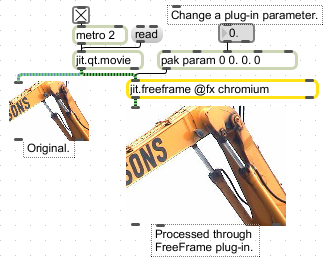Examples

FreeFrame Effects for Jitter matrices
| Name | IOProc | Planelink | Typelink | Dimlink | Plane | Dim | Type |
| in2 | resamp | 1 | 1 | 1 | 4 | 1 | char |
| out | n/a | 1 | 1 | 1 | 4 | 1 | char |
| anything | If the message selector matches the name of a parameter, functions like the message, taking a single (or , in the case of parameters) argument. If the message selector matches the word , followed by the name of a parameter (e.g. , the message has the same effect as the message, but requiring no further arguments. | |
| geteffectlist | Sends a list out the object's right outlet comprising the names of all available FreeFrame effects, preceded by the word . On Macintosh, FreeFrame effects must be located either in the /Library/Application Support/FreeFrame/> folder, or in a directory called FreeFrame Plugins , within the Max search path. On Windows, FreeFrame effects must be located either in the C:\Program Files\Common Files\FreeFrame\ folder, or in a directory called FreeFrame Plugins , within the Max search path. | |
| getparam | param [symbol/int] |
Sends a list out the object's right outlet containing the current value of the parameter specified by the param argument (either by name or by index into the list returned by ). The list is formatted as param param-val param-display . The param argument is the name of the parameters, the param-val the value, and param-display is an alternate display value, for parameters whose "real value", as understood by the parameter, lies outside of the range 0-1. |
| getparamlist | Sends lists out the object's right outlet describing the parameters for the currently selected effect, one list per parameter (see numparams). The list or lists are in the form param-name param-type . All parameters, regardless of type (with the exception of text ), accept a single floating-point number between 0 and 1 as input. The parameter types are: boolean , event , red , green , blue , xpos , ypos , text , standard . After all parameters have been listed, the message paramlist done is output. |
|
| loadeffect | effect-name [symbol] |
Selects an available FreeFrame effect for use. The effect must be specified by its name, as reported by the message. |
| param |
param [symbol/int] value [float/symbol] |
Sets the value of the parameter specified by the param argument (either by name or by index into the list returned by ). All parameters, regardless of type (with the exception of ), accept a single floating-point number between 0 and 1 as input. See the message for additional information on parameter types. |
| reload | Causes the object to rescan the FreeFrame plugins folders and add any new plugins to its list of effects. See the method for more details. |
| Name | Type | g/s | Description |
|---|---|---|---|
| fx | symbol | The currently loaded effect | |
| inmode | symbol | The matrix input mode (jitter/freeframe). The inmode and outmode attributes provide an optimization when building chains of jit.freeframe objects. Because Jitter and FreeFrame use different byte-padding, matrices generally have to be copied to a new buffer when the arrive at a jit.freeframe object, and copied back into a Jitter matrix after processing, before output. If several jit.freeframe objects will be used to sequentially process data, this copying step can be avoided. The first object in the chain should have inmode set to , and outmode set to . All subsequent objects should have both attributes set to , except for the last one, which should have inmode set to , and outmode set to . |
|
| numparams | int | (get) | The number of parameters for the currently loaded effect (default = -1) A value of indicates that there is no loaded effect. |
| outmode | symbol | The matrix output mode (jitter/freeframe). The inmode and outmode attributes provide an optimization when building chains of jit.freeframe objects. Because Jitter and FreeFrame use different byte-padding, matrices generally have to be copied to a new buffer when the arrive at a jit.freeframe object, and copied back into a Jitter matrix after processing, before output. If several jit.freeframe objects will be used to sequentially process data, this copying step can be avoided. The first object in the chain should have inmode set to , and outmode set to . All subsequent objects should have both attributes set to , except for the last one, which should have inmode set to , and outmode set to . |

| Name | Description |
|---|---|
| jit.qt.effect | QuickTime Effects for Jitter matrices |